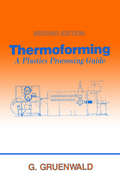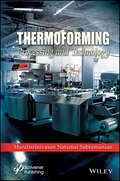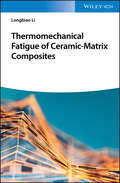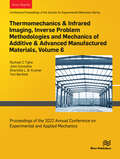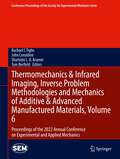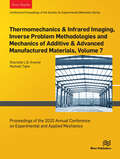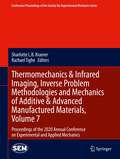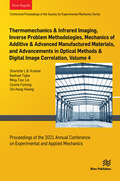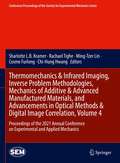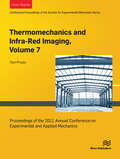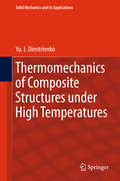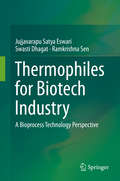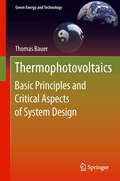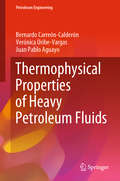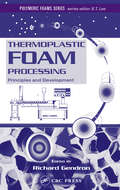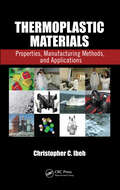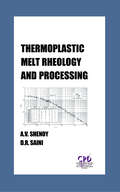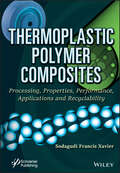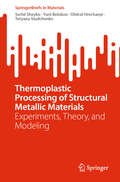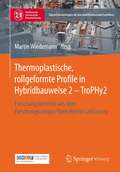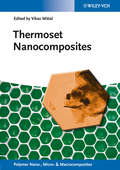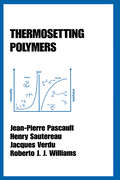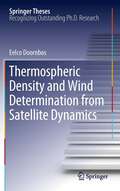- Table View
- List View
Thermoforming: A Plastics Processing Guide, Second Edition
by Geza GruenwaldFROM THE FOREWORDDr. Gruenwald has indicated the desirable properties of polymerics for differing applications; thus, his text is especially useful for polymer chemists who must ""tailor"" plastic materials for specific groups of applications. Engineers in extruding and calendering film and sheet will benefit from the intimate relationships elucidated between processing parameters imposed upon stocks employed in thermoforming and the products thereof. Mold designers are provided with a complete guide that will enable them to avoid the less obvious pitfalls and wasted effort so often experienced in the evolution of molds for (especially) complex parts.. Quite likely, Dr. Gruenwald's suggestions willl lead to considerable benefits to those who read and practice by this remarkable exposition of thermoforming technology. Robert K. Jordan Director-Metalliding Institute, Director-Engineering Research Institute, Scientist in Residence, Gannon University
Thermoforming: Processing and Technology
by Muralisrinivasan Natamai SubramanianThis book is a comprehensive reference manual that contains essential information on thermoforming processing and technology. The field of thermoforming is experiencing rapid development driven by commercial factors; millions of tons of polymers are manufactured for use in various applications, both as commodity and specialty polymers. Building on the previous edition published about ten years ago, this edition includes new, as well as, fully revised chapters and updated information on materials and processes. The book is designed to provide practitioners with essential information on processing and technology in a concise manner. The book caters to both engineers and experts by providing introductory aspects, background information, and an overview of thermoforming processing and technology. The troubleshooting section includes flowcharts to assist in correcting thermoforming processes. >em>Thermoforming: Processing and Technology offers a complete account of thermoplastics, covering properties and forming, with chapters providing perspective on the technologies involved. Readers will find it: serves as a handy knowledge source for professionals who occasionally work on thermoforming projects or need to refresh their knowledge; offers a troubleshooting guide that can help to identify and solve challenges that may arise in thermoforming processes; provides insights into process optimization, helping businesses improve efficiency, reduce waste, and enhance the quality of thermoformed products; acts as a course book to inform students about the thermoforming process. Audience The book will be of interest to mechanical, materials engineers, and process engineers who are involved in designing and optimizing thermoforming processes; professionals in the manufacturing and production industries who use thermoforming as a manufacturing method, such as in the production of plastic packaging, automotive components, and consumer goods; scientists, researchers, and students in plastics/polymer engineering and technology, materials science, polymer technology; professionals responsible for ensuring product quality and compliance with industry standards.
Thermomechanical Fatigue of Ceramic-Matrix Composites
by Longbiao LiGuides researchers and practitioners toward developing highly reliable ceramic-matrix composites The book systematically introduces the thermomechanical fatigue behavior of fiber-reinforced ceramic-matrix composites (CMCs) and environmental barrier coatings, including cyclic loading/unloading tensile behavior, cyclic fatigue behavior, dwell-fatigue behavior, thermomechanical fatigue behavior, and interface degradation behavior. It discusses experimental verification of CMCs and explains how to determine the thermomechanical properties. It also presents damage evolution models, lifetime prediction methods, and interface degradation rules. Thermomechanical Fatigue of Ceramic-Matrix Composites offers chapters covering unidirectional ceramic-matrix composites and cross-ply and 2D woven ceramic-matrix composites. For cyclic fatigue behavior of CMCs, it looks at the effects of fiber volume fraction, fatigue peak stress, fatigue stress ratio, matrix crack spacing, matrix crack mode, and woven structure on fatigue damage evolution. Both the Dwell-fatigue damage evolution and lifetime predictions models are introduced in the next chapter. Experimental comparisons of the cross-ply SiC/MAS composite, 2D SiC/SiC composite, and 2D NextelTM 720/Alumina composite are also included. Remaining sections examine: thermomechanical fatigue hysteresis loops; in-phase thermomechanical fatigue damage; out-of-phase thermomechanical fatigue; interface degradation models; and much more. -Offers unique content dedicated to thermomechanical fatigue behavior of ceramic-matrix composites (CMCs) and environmental barrier coatings -Features comprehensive data tables and experimental verifications -Covers a highly application-oriented subject?CMCs are being increasingly utilized in jet engines, industrial turbines, and exhaust systems Thermomechanical Fatigue of Ceramic-Matrix Composites is an excellent book for developers and users of CMCs, as well as organizations involved in evaluation and characterization of CMCs. It will appeal to materials scientists, construction engineers, process engineers, and mechanical engineers.
Thermomechanics & Infrared Imaging, Inverse Problem Methodologies and Mechanics of Additive & Advanced Manufactured Materials, Volume 6: Proceedings of the 2022 Annual Conference on Experimental and Applied Mechanics
by John Considine Rachael C Tighe Tom Berfield Kramer, Sharlotte L. B.Thermomechanics & Infrared Imaging, Inverse Problem Methodologies and Mechanics of Additive & Advanced Manufactured Materials, Volume 6 of the Proceedings of the 2022 SEM Annual Conference & Exposition on Experimental and Applied Mechanics, the sixth volume of six from the Conference, brings together contributions to this important area of research and engineering. The collection presents early findings and case studies on a wide range of areas, including: Test Design and Inverse Method Algorithms Inverse Problems: Virtual Fields Method Material Characterizations Using Thermography Fatigue, Damage & Fracture Evaluation Using Infrared Thermography Residual Stress Mechanics of Additive & Advanced Manufactured Materials.
Thermomechanics & Infrared Imaging, Inverse Problem Methodologies and Mechanics of Additive & Advanced Manufactured Materials, Volume 6: Proceedings of the 2022 Annual Conference on Experimental and Applied Mechanics (Conference Proceedings of the Society for Experimental Mechanics Series)
by John Considine Sharlotte L. B. Kramer Rachael C Tighe Tom BerfieldThermomechanics & Infrared Imaging, Inverse Problem Methodologies and Mechanics of Additive & Advanced Manufactured Materials, Volume 6 of the Proceedings of the 2022 SEM Annual Conference & Exposition on Experimental and Applied Mechanics, the sixth volume of six from the Conference, brings together contributions to this important area of research and engineering. The collection presents early findings and case studies on a wide range of areas, including: Test Design and Inverse Method Algorithms Inverse Problems: Virtual Fields Method Material Characterizations Using Thermography Fatigue, Damage & Fracture Evaluation Using Infrared Thermography Residual Stress Mechanics of Additive & Advanced Manufactured Materials
Thermomechanics & Infrared Imaging, Inverse Problem Methodologies and Mechanics of Additive & Advanced Manufactured Materials, Volume 7: Proceedings of the 2020 Annual Conference on Experimental and Applied Mechanics
by Rachael Tighe Kramer, Sharlotte L.B.Residual Stress, Thermomechanics & Infrared Imaging and Inverse Problems, Volume 7 of the Proceedings of the 2020 SEM Annual Conference & Exposition on Experimental and Applied Mechanics, the seventh volume of seven from the Conference, brings together contributions to this important area of research and engineering. The collection presents early findings and case studies on a wide range of areas, including: Test Design and Inverse Method Algorithms Inverse Problems: Virtual Fields Method Residual Stresses: Measurement, Uncertainty & Validation Residual Stresses: Eigenvalues, Modeling, & Crack Growth Material Characterizations Using Thermography Fatigue, Damage & Fracture Evaluation Using Infrared Thermography.
Thermomechanics & Infrared Imaging, Inverse Problem Methodologies and Mechanics of Additive & Advanced Manufactured Materials, Volume 7: Proceedings of the 2020 Annual Conference on Experimental and Applied Mechanics (Conference Proceedings of the Society for Experimental Mechanics Series)
by Sharlotte L. B. Kramer Rachel TigheResidual Stress, Thermomechanics & Infrared Imaging and Inverse Problems, Volume 7 of the Proceedings of the 2020 SEM Annual Conference & Exposition on Experimental and Applied Mechanics, the seventh volume of sseven from the Conference, brings together contributions to this important area of research and engineering. The collection presents early findings and case studies on a wide range of areas, including:Test Design and Inverse Method AlgorithmsInverse Problems: Virtual Fields MethodResidual Stresses: Measurement, Uncertainty & ValidationResidual Stresses: Eigenvalues, Modeling, & Crack GrowthMaterial Characterizations Using ThermographyFatigue, Damage & Fracture Evaluation Using Infrared Thermography
Thermomechanics & Infrared Imaging, Inverse Problem Methodologies, Mechanics of Additive & Advanced Manufactured Materials, and Advancements in Optical Methods & Digital Image Correlation, Volume 4: Proceedings of the 2021 Annual Conference and Exposition on Experimental and Applied Mechanics
by Cosme Furlong Ming-Tzer Lin Chi-Hung Hwang Rachael Tighe Kramer, Sharlotte L. B.Thermomechanics & Infrared Imaging, Inverse Problem Methodologies and Mechanics of Additive & Advanced Manufactured Materials, and Advancement of Optical Methods & Digital Image Correlation, Volume 4 of the Proceedings of the 2021 SEM Annual Conference & Exposition on Experimental and Applied Mechanics, the fourth volume of four from the Conference, brings together contributions to this important area of research and engineering. The collection presents early findings and case studies on a wide range of areas, including: Test Design and Inverse Method Algorithms, Inverse Problems: Virtual Fields Method, Material Characterizations, Using Thermography Fatigue, Damage & Fracture Evaluation Using Infrared, Thermography Mechanics of Additive & Advanced Manufactured Materials, DIC Methods & Its Application,s Photoelasticity and Interferometry Applications, Micro-Optics and Microscopic Systems, Multiscale and New Developments in Optical Methods.
Thermomechanics & Infrared Imaging, Inverse Problem Methodologies, Mechanics of Additive & Advanced Manufactured Materials, and Advancements in Optical Methods & Digital Image Correlation, Volume 4: Proceedings of the 2021 Annual Conference on Experimental and Applied Mechanics (Conference Proceedings of the Society for Experimental Mechanics Series)
by Cosme Furlong Ming-Tzer Lin Chi-Hung Hwang Sharlotte L. B. Kramer Rachael TigheThermomechanics & Infrared Imaging, Inverse Problem Methodologies and Mechanics of Additive & Advanced Manufactured Materials, and Advancement of Optical Methods & Digital Image Correlation, Volume 4 of the Proceedings of the 2021 SEM Annual Conference & Exposition on Experimental and Applied Mechanics, the fourth volume of four from the Conference, brings together contributions to this important area of research and engineering. The collection presents early findings and case studies on a wide range of areas, including: Test Design and Inverse Method Algorithms Inverse Problems: Virtual Fields Method Material Characterizations Using Thermography Fatigue, Damage & Fracture Evaluation Using Infrared Thermography Mechanics of Additive & Advanced Manufactured Materials DIC Methods & Its Applications Photoelasticity and Interferometry Applications Micro-Optics and Microscopic Systems Multiscale and New Developments in Optical Methods
Thermomechanics and Infra-Red Imaging, Volume 7: Proceedings of the 2011 Annual Conference on Experimental and Applied Mechanics
by Tom ProulxThermomechanics and Infra-Red Imaging represents one of eight volumes of technical papers presented at the Society for Experimental Mechanics Annual Conference on Experimental and Applied Mechanics, held at Uncasville, Connecticut, June 13-16, 2011. The full set of proceedings also includes volumes on Dynamic Behavior of Materials, Mechanics of Biological Systems and Materials, Mechanics of Time-Dependent Materials and Processes in Conventional and Multifunctional Materials, MEMS and Nanotechnology; Optical Measurements, Modeling and, Metrology; Experimental and Applied Mechanics, and Engineering Applications of Residual Stress.
Thermomechanics of Composite Structures under High Temperatures
by Yu. I. DimitrienkoThispioneering book presents new models for the thermomechanical behavior ofcomposite materials and structures taking into account internalphysico-chemical transformations such as thermodecomposition, sublimation andmelting at high temperatures (up to 3000 K). It is of great importance forthe design of new thermostable materials and for the investigation ofreliability and fire safety of composite structures. It also supports theinvestigation of interaction of composites with laser irradiation and thedesign of heat-shield systems. Structural methods are presented for calculating the effective mechanical andthermal properties of matrices, fibres and unidirectional, reinforced bydispersed particles and textile composites, in terms of properties of their constituentphases. Useful calculation methods are developed for characteristics such asthe rate of thermomechanical erosion of composites under high-speed flow andthe heat deformation of composites with account of chemical shrinkage. The author expansively compares modeling results with experimental data, andreaders will find unique experimental results on mechanical and thermalproperties of composites under temperatures up to 3000 K. Chapters show how thebehavior of composite shells under high temperatures is simulated by thefinite-element method and so cylindrical and axisymmetric composite shells andcomposite plates are investigated under local high-temperature heating.
Thermophiles for Biotech Industry: A Bioprocess Technology Perspective
by Swasti Dhagat Jujjavarapu Satya Eswari Ramkrishna SenThermophiles and hyperthermophiles exhibit great biotechnological potential, as they can be utilized in processes which require higher temperatures. This book comprehensively deals with all the aspects of thermophiles, starting from the source of these organisms to their latest applications. In addition it presents a compilation of all compounds produced by various thermophilic microorganisms. Due to their application in everyday life, the demands of enzymes that can work at higher temperature have been increasing. In order to keep pace with the increasing demand the industries have to search novel thermophiles producing their product of interest. Hence, this book will be of value for industries working on various biochemical products produced by these thermophiles as well as for scientists and research scholars working on microbiology and products derived from microorganisms.
Thermophotovoltaics
by Thomas BauerThermophotovoltaics is the science and technology associated with the direct generation of electricity from high temperature heat. Potential applications include combined heat and power, portable and auxiliary power, radioisotope space power, industrial waste heat recovery and concentrated solar power. This book aims at serving as an introduction to the underlying theory, overview of present day components and system arrangements, and update of the latest developments in the field. The emphasis is placed on the understanding of the critical aspects of efficient thermophotovoltaic system design. The aim is to assist researchers in the field.
Thermophysical Properties and Measuring Technique of Ge-Sb-Te Alloys for Phase Change Memory
by Rui LanThis book focuses on the thermophysical properties of Ge-Sb-Te alloys, which are the most widely used phase change materials, and the technique for measuring them. Describing the measuring procedure and parameter calibration in detail, it provides readers with an accurate method for determining the thermophysical properties of phase change materials and other related materials. Further, it discusses combining thermal and electrical conductivity data to analyze the conduction mechanism, allowing readers to gain an understanding of phase change materials and PCM industry simulation.
Thermophysical Properties of Heavy Petroleum Fluids (Petroleum Engineering)
by Bernardo Carreón-Calderón Verónica Uribe-Vargas Juan Pablo AguayoThis book addresses conventional and new predictive methodologies for estimating thermophysical properties of heavy petroleum fluids. For the unidentifiable fractions forming the fluids, chemical structures are calculated so that property estimation methods for mixtures of identifiable components are now available for such fractions. Chemical and multiphase equilibriums are of utmost importance; hence, the most significant ones involving heavy petroleum fluids are determined and illustrated using advanced equations of state such as sPC-SAFT and EoS/GE. The included phase equilibriums are phase envelopes of reservoir fluids, asymmetric mixtures between light solvents and bitumen including the presence of water and asphaltenes, among others. Besides, heavy petroleum fluids are analyzed from the Newtonian and non-Newtonian viewpoints, exploring their complex rheological behavior. Finally, complemented by online an Excel program for the thermodynamic characterization of unidentifiable petroleum fractions, this book is a useful resource for engineers and researchers in the petroleum industry and is also of interest to students studying chemical and petroleum engineering.
Thermoplasmonics: Heating Metal Nanoparticles Using Light
by Guillaume BaffouPlasmonics is an important branch of optics concerned with the interaction of metals with light. Under appropriate illumination, metal nanoparticles can exhibit enhanced light absorption, becoming nanosources of heat that can be precisely controlled. This book provides an overview of the exciting new field of thermoplasmonics and a detailed discussion of its theoretical underpinning in nanophotonics. This topic has developed rapidly in the last decade, and is now a highly-active area of research due to countless applications in nanoengineering and nanomedicine. These important applications include photothermal cancer therapy, drug and gene delivery, nanochemistry and photothermal imaging. This timely and self-contained text is suited to all researchers and graduate students working in plasmonics, nano-optics and thermal-induced processes at the nanoscale.
Thermoplastic Foam Processing: Principles and Development
by Richard GendronAs researchers seek replacements for banned, ozone-depleting foaming agents, the authors of Thermoplastic Foam Processing: Principles and Development strive to develop a better understanding of foaming processes and find solutions for day-to-day practice. This book presents the latest research in foam extrusion and physical foaming agents with a st
Thermoplastic Materials: Properties, Manufacturing Methods, and Applications
by Christopher C. IbehThis text offers a detailed presentation of thermoplastic materials that are commercially available for the plastics and polymer industries. It discusses chemical structure-property relationships and various categories of thermoplastic resins, including general purpose/commodity, quasicommodity, engineering, and specialty. Some of the thermoplastics covered include polycarbonate, nylon, ABS, and PMMA. Using a process-oriented format, the author explores application areas of thermoplastics to elucidate the interrelation and effect of processing on the properties and performance of these materials.
Thermoplastic Melt Rheology and Processing (Plastics Engineering)
by Aroon ShenoyPresents rheological data on a number of polymers, making use of the master curve approach to determine unified curves for each generic type of polymer. The text offers a step-by-step procedure for developing a speadsheet computer program to obtain accurate thermoplastic rheograms at any tempertature without using sophisticated rheometres. It inclu
Thermoplastic Polymer Composites: Processing, Properties, Performance, Applications and Recyclability
by Sodagudi Francis XavierTHERMOPLASTIC POLYMER COMPOSITES The monograph represents a life-long career in industry and academia and creates an exhaustive and comprehensive narrative that gives a complete understanding of important and state-of-the-art aspects of polymer composites including processing, properties, performance, applications & recyclability. Based on 40 years’ experience in both industry and academia, the author’s goal is to make a comprehensive and up-to-date account that gives a complete understanding of various aspects of polymer composites covering processing, properties, performance, applications & recyclability. Divided into 8 main chapters, the book treats thermoplastics vs. thermosets and the processing of thermoplastics; filled polymer composites; short fiber reinforced composites; long fiber reinforced composites; continuous fiber reinforced composites; nanocomposites; applications; and recycling polymer composites. Readers can have confidence that: Thermoplastic Polymer Composites (TPC) gives a comprehensive understanding of polymer composites’ processing, properties, applications, and their recyclability; Provides a complete understanding of man-made as well as natural fiber reinforced polymer (FRP) composites and explores in depth how short fiber, long fiber, and continuous fiber can transform the entire domain of composites’ processing and properties; Provides a deep understanding of nanocomposites with more than 50 examples covering both commodities as well as engineering thermoplastics. It presents conducting composites and several bio-medical applications of composites that are already passed through laboratories. Audience This unique reference book will be of great value to researchers and postgraduate students in materials science, polymer science, as well industry engineers in plastics manufacturing. Those working in product development laboratories of polymer and allied industries will also find it helpful.
Thermoplastic Processing of Structural Metallic Materials: Experiments, Theory, and Modeling (SpringerBriefs in Materials)
by Serhii Sheyko Yurii Belokon Oleksii Hrechanyi Tetyana VasilchenkoThis book discusses the scientific framework of thermoplastic deformation of structural metallic materials, in particular dual-phase steels and intermetallic alloys, emphasizing the attainment of desired alloy structures and properties through enhanced production techniques. By strategically manipulating the stress-strain state, a more uniform deformation is achieved, thereby fostering structural and property homogeneity. A novel experimental-theoretical approach is presented for correlating the stress-strain state with grain size and metal flow stress. Through extensive experimentation, flow curve dependencies and deformation resistance under varying temperature-velocity conditions are meticulously examined, facilitating their integration into specialized software platforms. Analytical formulations derived from experimental data enable the calculation of deformation resistance for special alloys and the establishment of optimal thermoplastic processing parameters. Aimed at scientific and technical professionals, as well as experts in metallurgy and materials science, this book offers invaluable insights into the advancement of alloy processing methodologies.
Thermoplastische, rollgeformte Profile in Hybridbauweise 2 - TroPHy2: Forschungsberichte aus dem Forschungscampus Open Hybrid LabFactory (Zukunftstechnologien für den multifunktionalen Leichtbau)
by Martin WiedemannDas Buch stellt den Abschlussbericht des Verbundprojektes „TroPHy2“ vor. In dem Projekt wurde eine Hybridrollformanlage entwickelt, mit der Hybridbauteile aus Metallprofilen und Kohlenstofffasern mit thermoplastischer Matrix hergestellt werden können. Diese Anlage wurde im Technikum der Open Hybrid LabFactory in Wolfsburg aufgebaut. Die Partner untersuchten und validierten die notwendigen Fertigungsprozesse. Ziel war es ein strukturmechanisch optimiertes, hybrides Automobilbauteil zu entwickeln, welches die Gewichtseinsparpotenziale hybrider Werkstoffe darstellt. Es wurde eine Gewichtsersparnis von bis zu 44,9 % errechnet, womit das zu Projektbeginn gesetzte Ziel von 25 % Gewichtsersparnis signifikant übertroffen wurde. Die Leichtbaupotenziale des hybriden Werkstoffes wurden dadurch deutlich herausgestellt.
Thermoset Nanocomposites
by Vikas MittalThe book discusses proven and promising methods to achieve a compatibilization between the organic and inorganic phases in thermoset polymers such as polyurethanes, phenolic resins, polyesters and epoxies. Of particular importance to the polymer engineer are the chapters dealing with compatibilization agents such as maleic anhydride elastomers, hydroxyl or carboxylic acid functionalized copolymers or metallocenes that catalyze the reactive processing. This title is essential reading for materials scientists, polymer chemists, chemical industry, and chemical engineers.
Thermosetting Polymers
by Jacques Verdu Jean-Pierre Pascault Roberto J. Williams Henry SautereauProvides comprehensive coverage of the most recent developments in the theory of non-Archimedean pseudo-differential equations and its application to stochastics and mathematical physics--offering current methods of construction for stochastic processes in the field of p-adic numbers and related structures. Develops a new theory for parabolic equat
Thermospheric Density and Wind Determination from Satellite Dynamics
by Eelco DoornbosThe Earth's atmosphere is often portrayed as a thin and finite blanket covering our planet, separate from the emptiness of outer space. In reality, the transition is gradual and a tiny fraction of the atmophere gases is still present at the altitude of low orbiting satellites. The very high velocities of these satellites ensure that their orbital motion can still be considerably affected by air density and wind. This influence can be measured using accelerometers and satellite tracking techniques. The opening chapters of this thesis provide an excellent introduction to the various disciplines that are involved in the interpretation of these observations: orbital mechanics, satellite aerodynamics and upper atmospheric physics. A subsequent chapter, at the heart of this work, covers advances in the algorithms used for processing satellite accelerometry and Two-Line Element (TLE) orbit data. The closing chapters provide an elaborate analysis of the resulting density and wind products, which are generating many opportunities for further research, to improve the modelling and understanding of the thermosphere system and its interactions with the lower atmosphere, the ionosphere-magnetosphere system and the Sun.
